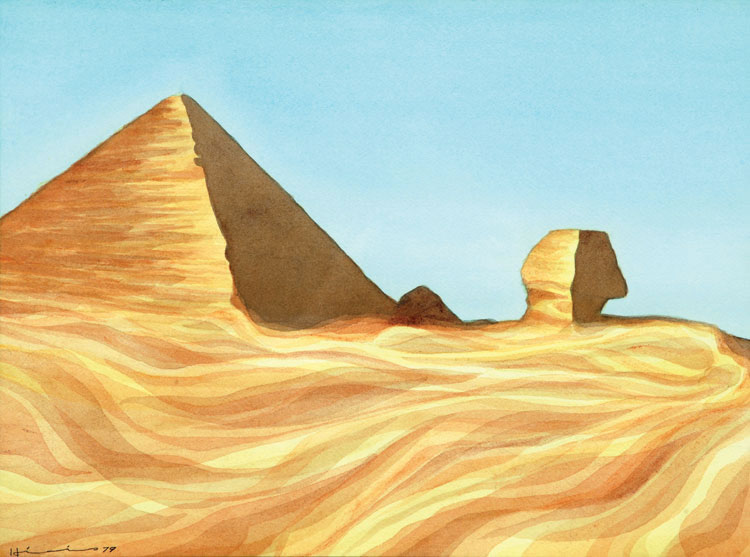One People, One Planet, HON!The Sphinx and Great Pyramid |
|
1979, watercolor, 18¾” x 22¼” There is a science to achieving the spiritual dimensions, and the ancient Egyptians were masters of these spiritual sciences. They also left behind instructions on how to safely enter and leave the mystical dimensions. Members of contemporary secret societies like Freemasonry and the Rosicrucian Order know that their rituals and mystery plays are based upon the same principles: learning the stages in the process of spiritualization and returning to the source. Hieronimus was looking forward to figuratively returning to the source and climbing the Great Pyramid and possibly exploring some past lifetimes when he and his wife and partner, Zohara, planned several trips to Egypt. What he didn’t expect was to be hit by a sandstorm when he was halfway up his climb to the top of the Great Pyramid. The swirling elements of the sandstorm are depicted in this painting of the Sphinx and Great Pyramid. He says throughout the blinding fierceness, as he clung to the rough stone, a tiny dot on the side a huge structure, he reminded himself he was clinging to the side of a temple. He went into an altered state and remembers experiencing the same thing he had while meditating inside the stone coffer inside the Great Pyramid. Lying in the red granite coffer like thousands of students and candidates for initiation had done before him was one of the most memorable experiences of his life. Although the current archeological theory is that the Great Pyramid was nothing more than a tomb for a vainglorious Pharaoh, many authorities today are challenging that status quo. Even President Sadat shared his belief that the pyramid was a symbol for meditation. Other theories for it today, besides it being an initiation chamber for the mystery schools, include that the pyramid was constructed to match up with Sirius or Orion in the sky, or that it was designed as a pump, or a power plant. The Sphinx is under even greater scrutiny in modern times as scientists from outside the boundaries of Egyptology use new data to determine the original date of construction. Water marks on the Sphinx, for example, have established that the Sphinx far outdates the accepted beginning of the Egyptian dynasties. Geologist Robert Schoch proved that the advanced civilization that built the Sphinx dates further back almost than we can comprehend.
|
